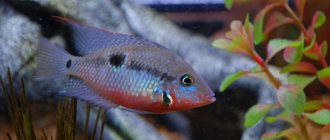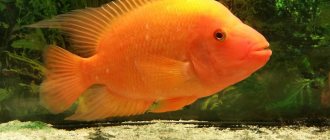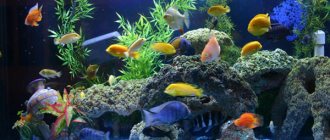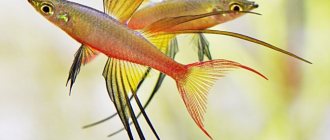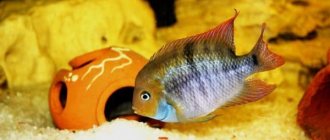Cichlazoma Meeka, Cichlazoma red-necked
Cichlasoma meeki
Cichlasoma meeki (Thorichthys meeki, Cichlasoma meeki) - being typical representatives of the order Perciformes, cichlids (or cichlids) are represented by more than 2000 species of fish. They include many bright and original varieties that live in home aquariums and have acquired the appropriate characteristics during selection for this purpose. It is to this category that the cichlazoma meeka belongs, which owes its name to the American ichthyologist.
What are they good for?
The first thing that attracts you is the appearance. You can’t help but pay attention to an aquarium with Cichlazoma meeka. The view fascinates and attracts with its originality. The fish are quite large (up to 15 cm in an aquarium, 35 cm in the wild). The accent is a red birthmark on the gills and throat, gradually spreading closer to the middle of the body. Hence the second name - red-necked cichlizoma. The general color has a violet tint with dark, blurry spots in the middle.
Swims slowly and gracefully. In this it is similar to Sedzhik's cichlazoma. True, this behavior occurs before the time of spawning. But then meeka is a hero, brave and fearless. Its aggression can become the main feature of behavior and provoke a threat to the lives of smaller and more peaceful inhabitants of the aquarium. True, Managuan cichlazoma has an even more explosive character.
Introduction
Many lovers of American cichlids consider Meek's cichlid one of the most beautiful aquarium fish. The first mention of this fish is found in the literature of the early 20th century - then this cichlid was described by the American scientist Walter Brind. Cichlazoma was named after the American ichthyologist Evgeniy Meek.
— Advertising —
At first, fish of this variety were classified as belonging to the genus Cichlasoma; later they were assigned to the genus Thorichthys. But the old name stuck so well that even now this cichlid is called Meek’s cichlid. In Latin the name of the fish is Thorichthys meeki, in Russian it is also called masked cichlosoma or redneck.
Under natural conditions, the fish is found in the waters of the Yucatan Peninsula, Mexico, and Guatemala.
In home aquariums, Cichlazoma Meeka can grow up to 12 cm. The body of the fish is tall, elongated in length and strongly curved from the back. The head of the fish is somewhat elongated with a very small mouth opening. The dorsal fin, like the anal fin, starts from the middle part of the body and ends at the very beginning of the tail fin, which in outline resembles a lyre. The paired fins are transparent with small turquoise spots. The unpaired fins have a red border. The iris of the eye is a brilliant turquoise hue. The body from the abdomen and the lower part of the gill covers are colored in various varieties of red, which is why the fish is called redneck. The gill covers have dark markings that resemble the pupils of eyes. In case of danger from the cichlid, Meeka spreads her gills to frighten the enemy. In a calm state, the gills acquire normal sizes. Because of this ability to dramatically change its appearance, the fish began to be called “mask fish”.
Male cichlazoma Meeka have a pronounced territorial character: they occupy an area at the bottom of the aquarium and protect it from uninvited guests. Females and fry lead a gregarious lifestyle.
Editorial: Otocinclus catfish
— Advertising —
In aquarium conditions, Cichlazoma Meeka lives from 5 to 10 years.
Lionhead cichlid
lion-headed cichlid (Steatocranus casuarius)
The swimming style of the lion-headed cichlid (Steatocranus casuarius) is very different from the meeka. When moving, it slightly pushes off from the bottom, moves in jerks or small jumps. This method of movement made it a bottom-dwelling fish with feeding and breathing habits.
The individual is unpretentious in nutrition, unlike the turquoise cichlid. An aquarist shouldn't worry too much. Live, artificial and frozen options are suitable. The fish do not refuse plant foods either. These are not South American cichlids, but, in particular, the blue-spotted acara. External similarity does not confirm the identity of characteristics.
Meeks feel comfortable when the bottom is sandy. Then they like to dig deeper into it, dig up rooted bushes of algae, turn over pebbles, in a word, create a certain “kettle” at the bottom. This is what distinguishes them from shell cichlids, which spend almost all their time hiding in empty shells located at the bottom. There they lay their eggs.
Cichlazoma Red-necked
Red-throats prefer to live in pairs . Even if there are worthy representatives of other fish in the aquarium, the couple separates from them and does not come into contact with them until the spawning period comes and everyone disturbs them.
Cichlasoma mesonauta
In contrast, Cichlazoma mesonauta feels comfortable in groups and gets along even with neighbors such as angelfish . This fact is explained by the timidity of individuals, like Cichlazoma mesonaut. Sometimes, out of fear, they can even jump out of the aquarium if they are in the upper part of the aquarium at the moment of apparent danger.
Compatibility
Although Eliot's cichlids become territorial during spawning, they are not aggressive at all other times. Instead, they have little arguments about who is bigger and more beautiful.
In this way, they again resemble Meek's cichlases; they also like to fluff up their fins and their luxurious throat to show others their beauty and coolness.
If you keep them with other, larger and more assertive cichlids, such as Flowerhorn or Astronotus, then things may end badly for Eliot's cichlids, since they are quite peaceful and not pugnacious.
Therefore, it is better to keep them with the same small or peaceful cichlids: Cichlazoma meeca, Cichlazoma severum, Nicaraguan cichlid, bluish-spotted acara.
But, nevertheless, keeping this cichlid with small fish such as neon or micro-digesting galaxies or glass shrimp means exposing Elitot’s cichlid to temptation.
Some aquarists keep them with swordtails, they scurry around and encourage Eliot to also behave more actively and boldly.
Of the catfish, ancistrus and cockroach are good choices, but it is better to avoid speckled catfish, as they are too small and live in the bottom layer.
How much water and what is desirable in the aquarium?
Jaguar Cichlid
Those who are interested in the Managuan cichlid should take care of a very large aquarium. But the “jaguar” appearance of such fish is worth it. The Jaguar Cichlid is an eccentric and freedom-loving individual that fully lives up to its name. Her appearance is a little frightening with its aggressiveness and incredible sharpness.
Cichlazoma Severum Red Pearl
But severum or false discus can live successfully in a fairly small volume of water. The main thing is that the water should be soft, have slightly dim lighting and be clear of food residues and other contaminants. Severum is great for inexperienced aquarists and grows quickly in size.
Cichlazoma labiatum
Unlike severum and Cichlazoma labiatum (another name for Cichlazoma labiatum), Cichlazoma Sedzhik does not dig up plant bushes and does not dig up the soil , building nests during spawning. She is quite calm and careful about the design around her.
Cichlazoma Sejika
But the katanga version requires not only a lot of water and the presence of plants, but also entire mountains of stones, where it is convenient and interesting for them to frolic.
Micro flavus cichlids in aquariums do not grow more than 8-10 cm, so the size of the aquarium may be more modest. True, the quality of the water must be ideal, taking into account aeration, filtration and a weekly change of a third of it.
Cichlids Katanga
The second option for small cichlids is the Nannakara cichlid. True, you should not count on peacefulness in her character. It can turn the life of forced neighbors into hell.
Another option for small fish is the parrot cichlid. It has a beautiful color, calm character and the ability to preserve the plants planted around it. Loves it when the aquarium is divided into zones.
Nannakara cichlid
parrot cichlid
Optimal conditions of detention
Adult meek cichlazomas are distinguished by good endurance, so caring for them is not very difficult. The only thing is that it must be regular and systematic.
Aquarium. The recommended volume is at least 50 liters for one pair, 150-200 liters for two or three pairs. Fish tend to jump out, so there must be a lid or glass on top.
Water parameters:
- temperature 22-27 degrees,
- hardness within 20,
- acidity 6.5-7.5.
Aeration and filtration. These fish need clean, oxygen-rich water with little current. They do not tolerate pollution well, so you will need to establish aeration and install a good filter (external or internal).
If it is not possible to install a biological filter, then 30-35 percent of the water should be changed weekly.
There are no special requirements for lighting, but meeks look more impressive in bright light. You can install fluorescent lamps with a total power of 0.5 W/l.
Bottom design. Digging and stirring up water are the favorite pastimes of these fish, so it is better to take small pebbles as soil. If it is sand, then only in a large and thick layer (from 8 cm).
Aquarium flora. Plants should have strong roots and tough leaves. Opt for Cryptocoryne, Echinodorus, Elodea, Vallisneria, and Anubias. It is better to plant plants in pots, since attempts to dig them up will be regular. The pots themselves can be covered with stones on top.
These cichlids need shelters. Therefore, you can decorate the aquarium with grottoes, driftwood, and ceramic pots. It's a good idea to build caves out of stones.
Breeding in an aquarium
Capable of breeding regularly in a community aquarium, it is more difficult to find a pair for each fish. Future parents “get to know each other” either at an early age or get used to each other as adults. These are monogamous creatures, choosing a mate forever.
Aquarium water should have the following parameters: acidity 7 pH, hardness 10o dGH, temperature - from 23 to 26 degrees. During the spawning period, the female produces 400-500 eggs per pre-prepared stone. After 7 days, swimming fry will appear, which will be looked after by their parents. It is interesting to observe individuals protecting their offspring - they are too jealous of strangers. Cichlazomy meeks spawn 2-3 times a year.
What other cyclides should I pay attention to?
Today, cichlazomas are species with quite different traits and characteristics.
Nicaraguan cichlisoma
Of course, this is the Nicaraguan cichlisoma - the most brightly colored creature in this niche. The body is almost golden, with the shine of a natural diamond. Plus: sky blue head and gills. And against the background of this splendor there is a bright scarlet belly, setting off the cold shine of gold.
Cichlazoma biocelatum (other names bee, eight-striped) is a very beautiful American cichlid, reaching the maximum beautiful
Cichlazoma biocelatum
coloration by the age of one year. The fry are less brightly colored, calmer and more self-possessed than their parents. If they can still put up with their neighbors in the aquarium, then adult individuals are not so sociable.
A chic (exhibition) option is the citron cichlazoma (not to be confused with cichlazoma labiatum). The calm and self-possessed citron cichlasoma gets angry only if the aquarium is crowded, if it experiences pressure from annoying neighbors. It feeds on small fish, fry and snails.
Citron cichlasoma
Therefore, he likes to live in places with good “infrastructure”: snags, stones,
protruding plant roots. True, when spawning in an ordinary aquarium, they may not retain the romantic yellow-lemon color. The citron cichlid is omnivorous and will not disdain even finely chopped vegetables such as cucumber. Its content does not pose any particular problems.
Cichlazoma labiatum is not only brightly colored (sometimes similar to yellow), but also
Cichlazoma labiatum
clearly visible charisma: it seems that her level of intelligence is high.
She follows her owner with her eyes, communicates with him at her own level, and can even visually ask for food. Cichlazoma labiatum has a second name - lipped. An interesting feature of this individual: when in close contact with the owner, it completely ignores neighboring fish and even representatives of its own species.
Cichlazoma wine
The inhabitant of Brazilian reservoirs, the wine cichlid, is also kind and gentle . Her “trick” is her behavior in case of fright. Freezing, the wine cichlid seems to turn into a dry leaf and fall to the bottom. Thanks to its mimicry coloring, it becomes almost invisible among brown soil and dark algae.
When forming an aquarium team, you should pay attention to the leopard cichlid option . Its peculiarity is that it can interbreed with other representatives of haplochromis.
leopard cichlid
Appearance
Having examined the various types of cichlases, it can be noted that most of them are relatively large, muscular fish with slender body proportions. Their body is high, laterally compressed. The mouth opening is large, the eyes are enlarged and black. The fins are well developed, elongated and pointed. Males of some species may have a fat fold above the eyes.
The color of the fish is very diverse; many representatives have scales with a metallic sheen. The color of the scales, as well as the maximum size in the aquarium, depends on the species and gender. The color may contain alternating stripes, as well as bright luminous spots of different sizes, sometimes reminiscent of the color of a jaguar. Male cichlases are usually larger than females. The sizes of adult cichlases range from 10 to 40 cm.
Editorial: Erythrozonus
It is worth noting that the scales of cichlases are very durable, real armor. This is not least responsible for their colossal endurance. Such skin easily resists pathogenic microflora. It turns out to be too much for even the simplest fish, so it is only very rare to encounter a common disease of aquarium fish - ichthyophthyriosis - in cichlases. Dense cover also helps a lot in skirmishes with relatives. Wounds received in fights heal right before our eyes.
Particularly original specimens
Auratus Cichlids
The species Auratus should be mentioned in this section. These fish have a second extravagant name: golden parrot. Females and males of Auratus differ significantly in color, which makes the choice easier at the time of pair formation, since the female of Auratus is even more pugnacious than the male. It is interesting that if there is no male in the house (aquarium), the most active and respected female can change her color and become like a male auratus. Auratus does not have the opposite effect.
The southern Malawian reservoir is the place where the blue dolphin originated - a striking representative of the cichlid, strongly reminiscent of the mammal of the same name. The pad on the male's forehead grows year by year, making the fish more and more like him. The success of their home breeding depends entirely on the health of the parents, which requires:
- bright lighting;
- filtering or changing a third of the water weekly;
- maintaining an alkaline pH.
Pseudotropheus Lombardo
A few words about the uniqueness of the Pseudotropheus Lombardo cichlid. It is important that only experienced aquarists can properly maintain a pawnshop. These are beautiful, aggressive individuals, extremely sensitive to changes in water. Female and male Lombardos are so differently colored that they are sometimes mistaken for different species. Lombardos do not get along even with peaceful cichlids.
Three-hybrid parrot - Cichlasoma flowerhorn
Three-hybrid parrot - Cichlasoma flowerhorn. This is the result of the selection work of ichthyologists. In addition to a highly developed bump on the forehead, it is characterized by:
- frequent radical changes in color;
- tendency to loneliness;
- the presence on the scales of a pattern similar to a heart.
Compatibility with other types
Meeka is a fairly peaceful fisherman. Manifestations of aggression are possible only during spawning, when the aquarium is overcrowded, as well as attempts to penetrate their territory, since they are very territorial. If you take care to avoid overcrowding in an artificial reservoir, then meeka gets along well with other inhabitants of the aquatic world.
Good neighbors for her will be:
- Akara;
- angelfish;
- locarii catfish;
- pterygoplichts:
- loricaria;
- Ancistrus.
The ideal option would be to be in proximity to large fish, similar in size to the meeka, but at the same time having the same calm character and lack of tendency to show aggression.
Conflict situations and fights can arise when living together with large and predatory fish or small fish, which the fish itself will perceive as food. Neighborhood with the following aquarium inhabitants is not recommended:
- cichlazoma black or golden;
- shellfish;
- veil fish;
- astronotus.
- Eliot;
- Sejika;
- Flamingo.
Are bright colors always a sign of cichlids?
With a general feature of having bright, expressive
Cichlazoma albino
coloring, there is an option - an exception to the rule. This is an albino cichlizoma. Confirming the validity of its name, it has no color or even shade .
It is white and transparent in places. She has one more feature: weak immunity and a tendency to disease (the opposite is Sedzhik cichlazoma). Based on this, caring for such fish requires special care and attention.
Dim and type of cichlazoma mezonauta. But this fish has a distinctive dark stripe along its entire body.
Severum representatives have rather discreet colors. In nature they are greenish with a yellow belly. Many bright and presentable color options have been selected for life in an aquarium. The most popular today are severum red pearl and severum striped blue emerald.
Compatibility
When selecting neighbors for a common aquarium, it is necessary to take into account the fact that all cichlids are extremely territorial fish. Having chosen one of the areas of the aquarium, they will not tolerate the invasion of strangers. But if in a normal period of life, the most that a neighbor who swims into someone else’s territory will receive is a small poke in the side, then during the period of nest construction and spawning, many species of cichlases become so aggressive that they can even kill any fish that gets into their reach.
When keeping several types of fish, one must not forget about the appropriate size of the aquarium. Many cichlids require a volume of 150 liters per couple, and taking into account other neighbors, this figure can increase several times.
When choosing roommates, you must first of all focus on the size of the fish. It is desirable if all individuals are proportionate, otherwise smaller species are endangered. It has been noted that if fish of different species live in an aquarium while they are still fry, then the overall aggression when they reach adult size is significantly less. The aquarium must provide enough cover so that the fish can hide from each other. If one of the species has spawned, then it is better to place the neighbors in another aquarium for a while. It is recommended to keep cichlases in pairs or groups with a predominance of females. Certain species (for example, Managuan cichlid) are best kept in species aquariums.
In a community aquarium, male fights are common.
In most cases, related species or other large cichlids are chosen as neighbors for cichlids - these can be either American or African species, the main thing is not to forget that their optimal water parameters may differ. Cichlazomas often do not pay any attention to large catfish (pterygoplichts, red-tailed catfish, clarius), so they can be safely housed together. Accordingly, small peaceful fish species are completely unsuitable for keeping together with cichlids; sooner or later they will become live food for voracious predators.
Manifestations of gender
Sedzhik's cichlazoma
But Sedzhik's cichlazoma is characterized by the appearance of various sexual characteristics by 5-7 months . By this time, the male becomes more massive and darker than the female, the fins acquire a characteristic shape and wine color (hence the second name: wine-finned). The female is smaller and lighter, the fatty growth on the forehead is less expressive.
An interesting feature of the male cichlid labiatum is that it “grows” a fatty bump on its forehead only during spawning. Later, it practically levels out on the general relief of the fish’s body.
The changes in adults during the periods of puberty and spawning in species such as orange cichlasoma (festacychlazoma) are original. With a characteristic bright orange color, the male becomes greenish in color at the time of spawning. However, this is not a guarantee that the female selected for pairing was suitable for him. The fact is that “orange” couples form from childhood. And the fish do not change their choice.
But wine cichlasoma, on the contrary, is characterized by the fact that the male must have the opportunity to choose a partner every time before spawning.
Among the Maingano there are no differences in the appearance of females and males throughout life.
Characteristic
In nature, it reaches 17 cm in length. In aquariums, some adult specimens are up to 10 - 12 cm. The fish has a wedge-shaped, elongated snout. The ends of the fins and the entire lower part of the body, including the gill covers, are brightly colored in all shades of red, like the flame of a fire. On the lower part of the gill cover on a light red field there is a black spot bordered with gold. The back and sides are light gray with dark stripes.
Sexual characteristics are expressed in the size, color and shape of the dorsal and anal fins. Females are smaller and paler than males, their fins have a rounded shape at the edges, while males are large, massive, their fins are pointed and elongated, and they are much brighter in color, especially during the spawning period.
Breeding
Sexual maturity in the red-headed cichlazoma occurs at the age of eight months, rarely about a year. During spawning, the already bright color of the male becomes even more saturated. The background of the body takes on purple shades, and the red apron becomes even brighter. The male's behavior becomes even more aggressive. Spawning can take place both in a general aquarium and in a separate spawning tank. The stimulus for spawning is the replacement of a significant percentage of water with fresh and warmer water. Meek's cichlazomas choose ceramic pots, flat stones or other similar shelter as a spawning site. For safety reasons, during spawning that occurs in a common aquarium, it is advisable to remove neighbors, if any. In the litter of red-headed cichlases there are up to 700 eggs, usually the number of eggs is about 300. The parents eat the unfertilized eggs immediately after they appear. Both parents care for the offspring. The male “patrolls” the territory adjacent to the spawning site, and the female uses her fins to ventilate the clutch, thus creating water circulation around the eggs, enriching them with oxygen. The incubation period is 3-7 days, at the end of which, before the larvae hatch, the parents transfer all the eggs to a hole dug in advance. While caring for the fry, the male can transfer the offspring to a new shelter several times. And during this period, in order to lay down the offspring, he may even dig up plants that seem to be in the way. On the fourth day, the yolk sac of the fry resolves, and they begin to swim independently, although some fry begin to attempt to swim on the second or third day of life. From this moment you can start feeding the fry. Artemia nauplii are suitable as starter food. A little later, when the young animals have become stronger, they can be included in the diet of Cyclops to improve coloration. Initially, the color of the fry is grayish with a slight yellowish or bluish tint. Upon reaching a size of two centimeters (sometimes a little earlier), the gill covers “bloom” with pink spots, becoming red over time. Sometimes masked cichlazomas for some reason become cannibals and eat their offspring. To avoid such cases, the offspring are taken from the parents at the egg stage, removed completely from the substrate, and transferred to a separate 30-40 liter container with the same water parameters as in a general aquarium. Strong aeration of the container is a prerequisite for the development of larvae. The fry do not tolerate the slightest appearance of nitrates or turbidity of the water; moreover, uncollected waste products lead to the death of the young. Therefore, the nursery aquarium must be kept clean. The sponge filter should not be too powerful so that the fry are not sucked in. In addition, it is recommended to carefully remove dirt from the bottom using a siphon. Thorough cleaning of the aquarium and frequent water changes are necessary in any case: whether the offspring are developing in a separate container or in a common aquarium. Constant protein food promotes rapid growth. Such simple steps will help avoid the loss of the entire brood.
Description
For the first time, the cichlid meeka became known in 1918, thanks to the scientist Brind. The name was given to it in honor of the compiler of the world's first book about the fish of Mexico, namely Seth Eugene Meek. Distinctive external characteristics of individuals are:
- silver-violet body color, the presence of vertical spots of a dark shade;
- red tint to gills and throat;
- large sizes (10-17 cm in length);
- slender, laterally compressed body;
- pointed muzzle with sloping forehead;
- the presence of large fins with pointed ends.
Many people wonder how long the described representatives of cichlids live. With proper care and maintenance in captivity, they can survive for about ten years. The above is a general description of the fish, however, in their natural habitat, their color may vary somewhat due to the region and parameters of the water masses.
Content Features
Cichlaz Meeka can be classified as an unpretentious and hardy inhabitant of the aquarium. But their content has its own rules that must be taken into account.
Aquarium
For a pair of Meeka cichlases, you need an aquarium with a volume of at least 50 liters. If you plan to have two or three pairs, then the capacity should be 150 or 200 liters, respectively. It is better and more economical if the container is straight and rectangular in shape. An aquarium of this volume, round in shape, will take up too much space. Be sure to provide the aquarium with a lid so that these hectic creatures do not jump out of it.
— Advertising —
Cichlazomas Meeka love cleanliness very much, so external and internal filters must be installed in their home. To saturate the water with oxygen, a compressor is required - for fish of this type, aeration is needed around the clock.
Water
The aquarium is filled with settled water with a slightly acidic or neutral reaction. The water temperature is maintained within 22-24 degrees. Meek's cichlazomas do not tolerate excess nitrogen compounds in the aquatic environment, so it is advisable to have a biological filter for its purification. If there is no such device, then change 30% of the water volume every week.
Soil and algae
Cichlazomas Meeka love to dig in the ground and pull out algae, so heavy particles - small pebbles or granite chips - will be added to the bottom of the aquarium with these fish. Algae are placed in small flowerpots or in river sand (the thickness of the sand coating must be at least 8 cm).
You can decorate the aquarium with a variety of grottoes and shelters made of large stones or shards.
